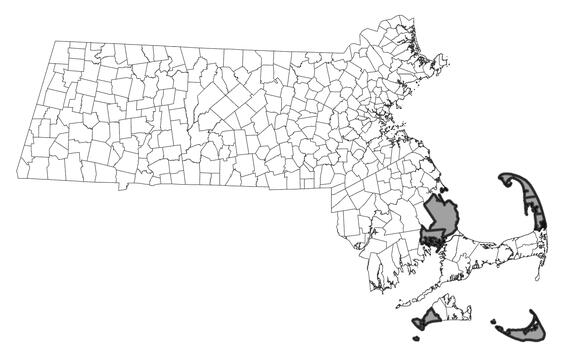- Scientific name: Corema conradii (Torr.) Torr. ex Loudon
- Species of Greatest Conservation Need (MA State Wildlife Action Plan)
Description
Broom crowberry (Corema conradii), a member of the heath family (Ericaceae), is a low-growing evergreen shrub of barrens, heathlands, and dunes. It has short, needle-like leaves and small, purplish flowers that bloom very early in spring. Broom crowberry is a densely branched evergreen shrub, up to 50 cm (20 in) in height and 2 m (6.5 ft) wide. It has linear, alternate leaves up to 6 mm (0.2 in) long. The flowers are reddish or purplish and lack petals. They are borne in small, sessile, terminal heads and are subtended by sepal-like bracts. The fruit is a very small drupe (1.5 mm [<0.1 in]) with three seeds.
Broom crowberry is similar in appearance to a common habitat associate, golden heather (Hudsonia ericoides). Golden heather is also a low-growing, spreading, evergreen shrub of barrens, dunes, and heathlands, with linear, alternate leaves. However, unlike broom crowberry, golden heather has axillary, solitary flowers, with definite pedicels, and five yellow petals. Introduced heathers (Calluna vulgaris; Erica spp.) are superficially similar to broom crowberry, but have opposite or whorled leaves, and whitish or pinkish flowers that bloom in mid to late summer.
Life cycle and behavior
Broom crowberry has short, needle-like leaves and small, purplish flowers that bloom very early in spring.
Population status
Broom crowberry is a species of greatest conservation need and is maintained on the plant watch list. It is currently known from Barnstable, Dukes, Nantucket and Plymouth Counties, and is historically known from Essex County.
Distribution and abundance
Broom crowberry is endemic to northeastern North America, and occurs in Nova Scotia, Quebec, Prince Edward Island, New Brunswick, Maine, Massachusetts, New York, and New Jersey. Broom crowberry is rare in Quebec, Prince Edward Island, New Brunswick, Maine, Massachusetts, New York, and New Jersey.

Distribution in Massachusetts
1999-2024
Based on records in the Natural Heritage Database
Habitat
In Massachusetts, broom crowberry inhabits sandy, dry, low-nutrient soils of open heathlands, dunes, and pitch pine-scrub oak barrens. It requires open habitat with minimal shade; periodic disturbance, such as fire, is required to maintain suitable habitat conditions. Associated plants include pitch pine (Pinus rigida), scrub oak (Quercus ilicifolia), bearberry (Arctostaphylos uva-ursi), golden heather (Hudsonia ericoides), Canadian rockrose (Helianthemum canadense), common hairgrass (Deschampsia flexuosa), and reindeer lichen (Cladonia rangiferina).
Healthy habitats are vital for supporting native wildlife and plants. Explore habitats and learn about conservation and restoration in Massachusetts.
Threats
Threats to broom crowberry include conversion of habitat for development, exclusion of disturbance (or rather, the resulting over-shading from habitat succession to dense woody vegetation cover), deer browse, and trampling. The hostile environment of barrens excludes many exotic invasive plants, but a few species, such as Scotch broom (Cytisus scoparius), may become established; the impacts of exotic plants on broom crowberry are not well-documented.
Conservation
The exact management needs of broom crowberry are not known. Research has shown that fire disturbance is beneficial in maintaining populations of broom crowberry. Though adult plants are often killed during a fire, burning maintains habitat quality by removing competing or over-shading woody vegetation, and providing a hospitable seed bed; seeds establish readily following fires. Habitat sites should be monitored for over-shading caused by habitat succession to dense shrub or tree cover. If trampling or erosion are threats in recreational areas, trails can be stabilized or re-routed.
Contact
| Date published: | April 10, 2025 |
|---|